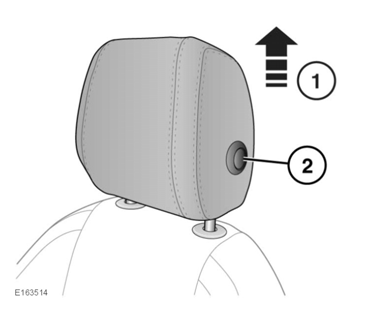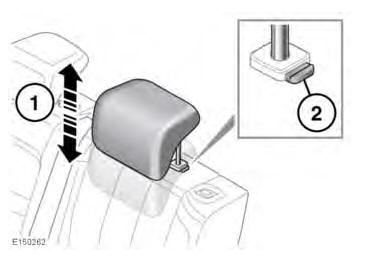Land Rover Discovery: Head restraints
FRONT HEAD RESTRAINTS
Adjust the head restraint so that the top of the head restraint is above the centre line of the head.
An incorrectly adjusted head restraint increases the risk of death or serious injury in the event of a collision.
Do not drive, or carry passengers with the head restraints removed from occupied seats. The absence of a correctly adjusted head restraint increases the risk of neck injury in the event of a collision.
Never adjust the head restraints while the vehicle is in motion.
Always store a removed head restraint securely.

- Move the head restraint up to the required position.
- To move the restraint downwards, press the button on the side of the head restraint and move the restraint to the required position.
Note: Head restraints fitted with Rear seat entertainment screens must NOT be removed.
2 people are required when removing a front head restraint.
To remove the head restraint:
- Move the head restraint to the upper most position.
- Using 2 hands, press down on each of the collars on the top of the seat to engage hidden buttons inside the seat.
- While the collars are being pressed down, the second person should lift out the head restraint.
Make sure the head restraint is refitted before the seat is used by a passenger.
To refit the head restraint:
- Press the button on the side of the head restraint and push the stems into the restraint as far as they will go.
- Line the stems up with the hole in the collars and push down until both stems engage into the locked position.
REAR HEAD RESTRAINTS
Adjust the head restraint so that the top of the head restraint is above the centre line of the head.
An incorrectly adjusted head restraint increases the risk of death or serious injury in the event of a collision.
Do not drive or carry passengers with the head restraint removed from an occupied seat. The absence of a correctly adjusted head restraint increases the risk of neck injury in the event of a collision.
Always store a removed restraint securely.
The head restraints can be removed, if required (e.g., to fit larger child seats). To remove a head restraint, first raise the head restraint to its uppermost position.
With the adjusting collar pressed in, lift the restraint out of the seatback.
To refit a head restraint, make sure it is facing the correct direction, insert the stems of the head restraint into the sockets and push it downwards until at least the first click.

- To raise, pull the head restraint upwards.
- To lower, press in the adjusting collar and push down on the head restraint.

